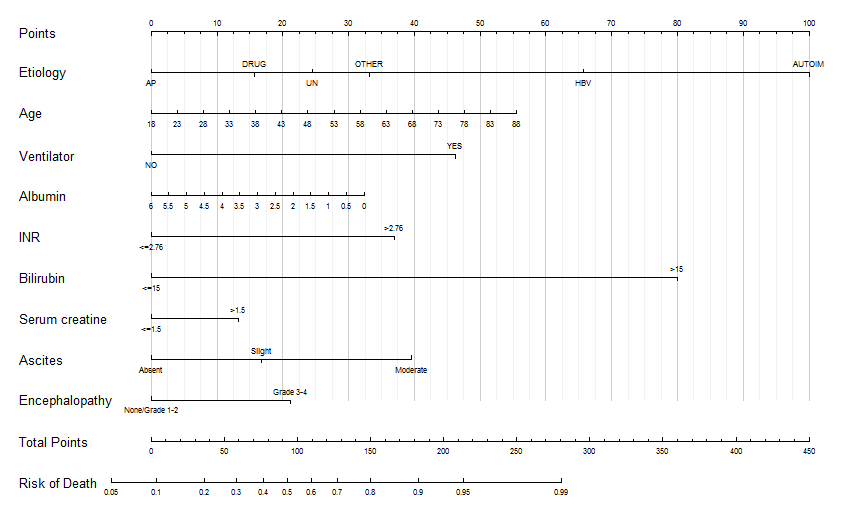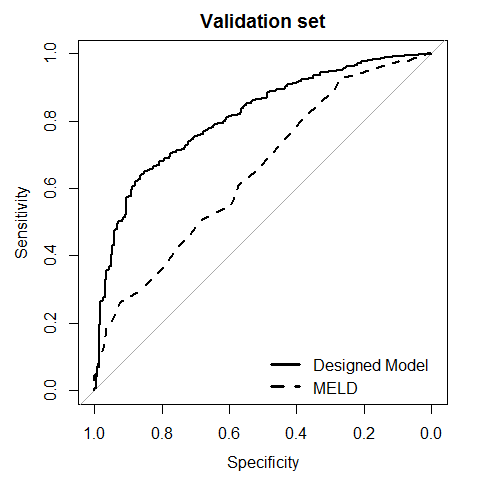Development and Validation of an FLF-Transplant Score to Predict Mortality of Patients with Fulminant Liver Failure.
The First Affiliated Hospital of Sun Yat-sen University, Guangzhou, China
Meeting: 2017 American Transplant Congress
Abstract number: C183
Keywords: Liver failure
Session Information
Session Name: Poster Session C: Organ Allocation, Meld Score, Organ Utilization, and Transplant Outcomes
Session Type: Poster Session
Date: Monday, May 1, 2017
Session Time: 6:00pm-7:00pm
 Presentation Time: 6:00pm-7:00pm
Presentation Time: 6:00pm-7:00pm
Location: Hall D1
BACKGROUND & AIMS: We aimed to develop a simple prognostic model in predicting fulminant liver failure (FLF) patient mortality within 14 days after being listed on the waiting list.
METHOD: A total of 4004 patients with FLF who were listed for liver transplantation were enrolled for model formation (n=2782) and validation (n=1222). Through univariate and multivariate logistic analysis, independent risk factors were selected to develop the logistic regression model and construct a nomogram. Discrimination was evaluated by calculating the area under the receiver operating characteristic (AUROC) and calibration by calibration plot and the Hosmer-Lemeshow test.
RESULTS: Etiology, age, international normalized ratio >2.76, bilirubin >15mg/dL, serum creatinine >1.5mg/dL, ventilator use, ascites, Grade 3-4 hepatoencephalopathy were independent predictors for early mortality of FLF patients on the waiting list.  The constructed logistic regression model (FLF-transplant score) demonstrated good calibration with excellent discrimination with an AUROC of 0.8031 (0.7833-0.8228) in training set and 0.785 (0.7541-0.8159) in the validation set. The Hosmer-Lemeshow test demonstrated good fitness between prediction and actual results in both training (P=0.4514) and validation (P=0.1625) sets. The performance of constructed model was superior to MELD score with an AUROC of 0.5761 (0.5418-0.6105) in the validation set (P<0.001).
The constructed logistic regression model (FLF-transplant score) demonstrated good calibration with excellent discrimination with an AUROC of 0.8031 (0.7833-0.8228) in training set and 0.785 (0.7541-0.8159) in the validation set. The Hosmer-Lemeshow test demonstrated good fitness between prediction and actual results in both training (P=0.4514) and validation (P=0.1625) sets. The performance of constructed model was superior to MELD score with an AUROC of 0.5761 (0.5418-0.6105) in the validation set (P<0.001). Cirrhotic patients with a MELD score > 40 showed a higher 14-day mortality rate than Status 1A patients with a FLF-transplant score < 200 (P<0.001).
Cirrhotic patients with a MELD score > 40 showed a higher 14-day mortality rate than Status 1A patients with a FLF-transplant score < 200 (P<0.001).
CONCLUSIONS: The model developed here show good discrimination and calibration in predicting on-waiting-list mortality. The allocation policy for the FHF patients should be re-considered based on the FLF-transplant score.
CITATION INFORMATION: Guo Z, Chen B, He X, Chen G. Development and Validation of an FLF-Transplant Score to Predict Mortality of Patients with Fulminant Liver Failure. Am J Transplant. 2017;17 (suppl 3).
To cite this abstract in AMA style:
Guo Z, Chen B, He X, Chen G. Development and Validation of an FLF-Transplant Score to Predict Mortality of Patients with Fulminant Liver Failure. [abstract]. Am J Transplant. 2017; 17 (suppl 3). https://atcmeetingabstracts.com/abstract/development-and-validation-of-an-flf-transplant-score-to-predict-mortality-of-patients-with-fulminant-liver-failure/. Accessed December 17, 2025.« Back to 2017 American Transplant Congress
